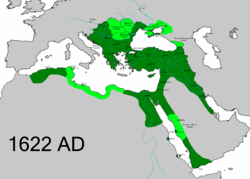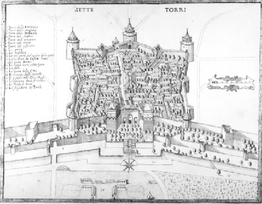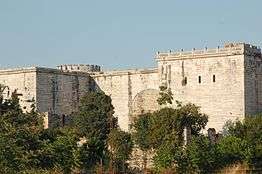Osman II
| Osman II عثمان ثانى | |||||
|---|---|---|---|---|---|
|
Sultan of the Ottoman Empire Kayser-i Rûm Custodian of the Two Holy Mosques Caliph of Islam | |||||
|
| |||||
| 16th Ottoman Sultan (Emperor) | |||||
| Reign | 26 February 1618 – 20 May 1622 | ||||
| Predecessor | Mustafa I | ||||
| Successor | Mustafa I | ||||
| Born |
November 3, 1604 Topkapi Palace, Istanbul, Ottoman Empire | ||||
| Died |
May 20, 1622 (aged 17) Yedikule Fortress, Istanbul, Ottoman Empire | ||||
| Burial | Sultan Ahmed Mosque, Istanbul | ||||
| Consorts |
Ayşe Sultan Akile Hatun Meleksima Sultan | ||||
| Issue |
Şehzade Ömer Shezade Mustafa Zenep Sultan | ||||
| |||||
| Dynasty | Ottoman | ||||
| Father | Sultan Ahmed I | ||||
| Mother | Mahfiruz Hatice Sultan | ||||
| Religion | Sunni Islam | ||||
| Tughra |
| ||||
Osman II (Ottoman Turkish: عثمان ثانى ‘Osmān-i sānī; 3 November 1604 – 20 May 1622), commonly known in Turkey as Genç Osman ("Osman the Young" in English), was the Sultan of the Ottoman Empire from 1618 until his death by regicide on 20 May 1622.
Early life
Osman II was born at Topkapı Palace, Constantinople, the son of Sultan Ahmed I (1603–17) and his first wife Mahfiruz Hatun. According to later traditions, at a young age, his mother had paid a great deal of attention to Osman's education, as a result of which Osman II became a known poet and would have mastered many languages, including Arabic, Persian, Greek, Latin, and Italian; this has been refuted since.[1]
Osman's failure to capture the throne at the death of his father Ahmed may have been caused by the absence of a mother to lobby in his favor; his own mother probably already dead or in exile.
Reign

Osman II ascended the throne at the age of 14 as the result of a coup d'état against his uncle Mustafa I "the Intestable" (1617–18, 1622–23). Despite his youth, Osman II soon sought to assert himself as a ruler, and after securing the empire's eastern border by signing a peace treaty (Treaty of Serav) with Safavid Persia, he personally led the Ottoman invasion of Poland during the Moldavian Magnate Wars. Forced to sign a peace treaty with the Poles after the Battle of Chotin (Chocim) (which was, in fact, a siege of Chotin defended by the Lithuanian–Polish hetman Jan Karol Chodkiewicz) in September–October, 1621, Osman II returned home to Constantinople in shame, blaming the cowardice of the Janissaries and the insufficiency of his statesmen for his humiliation.
The basic and exceptional weakness from which Osman II suffered was the conspicuous absence of a female power basis in the harem. From 1620 until Osman's death, a governess (daye hatun, lit. wet-nurse) was appointed as a stand-in valide, and she could not counterbalance the contriving of Mustafa I's mother in the Old Palace. Although he did have a loyal chief black eunuch at his side, this could not compensate for the absence of what in the politics of that period was a winning combination, valide sultan–chief black eunuch, especially in the case of a young and very ambitious ruler.[2] According to Piterberg, Osman II did not have haseki sultan, opposite with Peirce who claim that Ayşe was Osman's haseki. But it is clear that Ayşe could not take valide's role during her spouse's reign.
Death



Seeking a counterweight to Janissary influence, Osman II closed their coffee shops (the gathering points for conspiracies against the throne) and started planning to create a new and more loyal army consisting of Anatolian sekbans.[3] The result was a palace uprising by the Janissaries, who promptly imprisoned the young sultan in Yedikule Fortress in Istanbul, where Osman II was strangled to death.[4]
Family
- Consorts
Osman had three consorts:
- Ayşe Sultan, his haseki, of unknown background;[5]
- Meleksima Sultan, his haseki, of unknown background;
- A woman said to be the daughter of an astrologer, and granddaughter of Pertev Mehmed Pasha;[6]
- Akile Hatun (m. March 1622), daughter of Şeyhülislam Mehmed Esadullah Efendi;[5][6]
- Son
Osman had two sons:
- Şehzade Ömer (died in infancy).
- Shezade Mustafa (died in infancy).
- Daughter
Osman had one daughter:
- Zeynep Sultan(died in infancy).
In popular culture
In the 2015 Turkish television series Muhteşem Yüzyıl: Kösem, Osman II was portrayed by actor Taner Ölmez.[7]
See also
Notes
- ↑ Tezcan, Baki (2002). "The 1622 Military Rebellion in Istanbul : A Historiographical Journey". International Journal of Turkish Studies. University of Wisconsin: 40.
Stanford Shaw, the author of an Ottoman history that has been widely used as a textbook and reference work, claims, on the basis of information from an eighteenth-century French novel,84 that the sultan was "[t]rained in Latin, Greek, and Italian by his Greek mother, as well as Ottoman Turkish, Arabic, and Persian."85
- ↑ Piterberg, Gabriel (2003). An Ottoman Tragedy: History and Historiography at Play. California: University of California Press. p. 18. ISBN 0-520-23836-2.
- ↑ Ozgen, Korkut. "The Family: The Sultans: Osman II." The Ottomans. 2002. http://www.theottomans.org.
- ↑ Piterberg, Gabriel (2003). An Ottoman Tragedy: History and Historiography at Play. Berkeley: University of California Press. p. 28. ISBN 0-520-23836-2.
- 1 2 Peirce, Leslie P. (1993). The Imperial Harem: Women and Sovereignty in the Ottoman Empire. Oxford University Press. p. 106. ISBN 978-0-195-08677-5.
- 1 2 Tezcan, Baki (2001). Searching For Osman: A Reassessment Of The Deposition Of Ottoman Sultan Osman II (1618-1622). pp. 377 n. 93.
- ↑ "Muhteşem Yüzyıl Kösem sezon finalinde bakın kimler ayrıldı!" (in Turkish). Retrieved 2017-11-06.
External links
![]()
Osman II Born: November 3, 1604 Died: May 20, 1622 | ||
| Regnal titles | ||
|---|---|---|
| Preceded by Mustafa I |
 Sultan of the Ottoman Empire Feb 26, 1618 – May 20, 1622 |
Succeeded by Mustafa I |
| Sunni Islam titles | ||
| Preceded by Mustafa I |
Caliph of Islam Ottoman Caliph Feb 26, 1618 – May 20, 1622 |
Succeeded by Mustafa I |